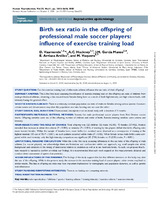Mostrar el registro sencillo del ítem
Birth sex ratio in the offspring of professional male soccer players: influence of exercise training load
| dc.contributor.author | Vaamonde, Diana | |
| dc.contributor.author | Hackney, A.C. | |
| dc.contributor.author | Garcia Manso, J.M. | |
| dc.contributor.author | Vaquero Abellán, Manuel | |
| dc.date.accessioned | 2024-01-17T14:03:04Z | |
| dc.date.available | 2024-01-17T14:03:04Z | |
| dc.date.issued | 2020 | |
| dc.identifier.uri | http://hdl.handle.net/10396/26596 | |
| dc.description.abstract | Study question: Can the exercise training load of elite male athletes influence the sex ratio of their offspring? Summary answer: This is the first study assessing the influence of exercise training load on the offspring sex ratio of children from male professional athletes, observing a bias toward more females being born as a result of both high-intensity and high-volume loads, with intensity having the greatest effect. What is known already: There is a relatively constant population sex ratio of males to females among various species; however, certain events and circumstances may alter this population sex ratio favoring one sex over the other. Study design, size, duration: Observational, descriptive cross-sectional study with a duration of 3 months. Participants/materials, setting, methods: Seventy-five male professional soccer players from First Division soccer teams. Offspring variables were sex of the offspring, number of children and order of birth. Exercise training variables were volume and intensity. Main results and the role of chance: Total offspring was 122 children (52 males (42.6%), 70 females (57.4%)). Analysis revealed that increase in either the volume (P < 0.001) or intensity (P < 0.001) of training by the players shifted the birth offspring ratio more toward females. Within the sample of females born, more births (i.e. number) were observed as a consequence of training at the highest intensity (45 out of 70; P < 0.001), no such pattern occurred within males (P > 0.05). When female versus male births were compared within each intensity, only the high-intensity comparison was significant (45 (75%) females vs 15 (25%) males, P < 0.001). Limitations, reasons for caution: While this is the first study assessing differences in the sex ratio of the offspring of male athletes (i.e. soccer players), we acknowledge there are limitations and confounders within our approach; e.g. small sample size, ethnic background and variations in the timing of intercourse relative to ovulation as well as in sex hormone levels. As such, we propose that future research is needed to confirm or refute our findings. It is recommended that such work expand on the measurements obtained and conduct direct assessment of sperm characteristics. Wider implications of the findings: The findings of the study support the fact that different stressors on the body may alter the sex of the offspring. While in the present study the stressor is the excessive training load of soccer players, other events may lead to similar results. The bias in offspring sex ratio may have important implications for demography and population dynamics, as well as genetic trait inheritance. | es_ES |
| dc.format.mimetype | application/pdf | es_ES |
| dc.language.iso | eng | es_ES |
| dc.publisher | Oxford University Press | es_ES |
| dc.rights | https://creativecommons.org/licenses/by-nc-nd/4.0/ | es_ES |
| dc.source | Vaamonde, D., Hackney, A. C., García Manso, J. M., & Vaquero Abellán, M. (2020). Birth sex ratio in the offspring of professional male soccer players: influence of exercise training load. Human Reproduction, 35(11), 2613-2618. https://doi.org/10.1093/humrep/deaa225 | es_ES |
| dc.subject | Children | es_ES |
| dc.subject | Exercise intensity | es_ES |
| dc.subject | Exercise volume | es_ES |
| dc.subject | Male reproduction | es_ES |
| dc.subject | Sports | es_ES |
| dc.subject | Training intensity | es_ES |
| dc.subject | Training volume | es_ES |
| dc.title | Birth sex ratio in the offspring of professional male soccer players: influence of exercise training load | es_ES |
| dc.type | info:eu-repo/semantics/article | es_ES |
| dc.relation.publisherversion | http://dx.doi.org/10.1093/humrep/deaa225 | es_ES |
| dc.rights.accessRights | info:eu-repo/semantics/openAccess | es_ES |

